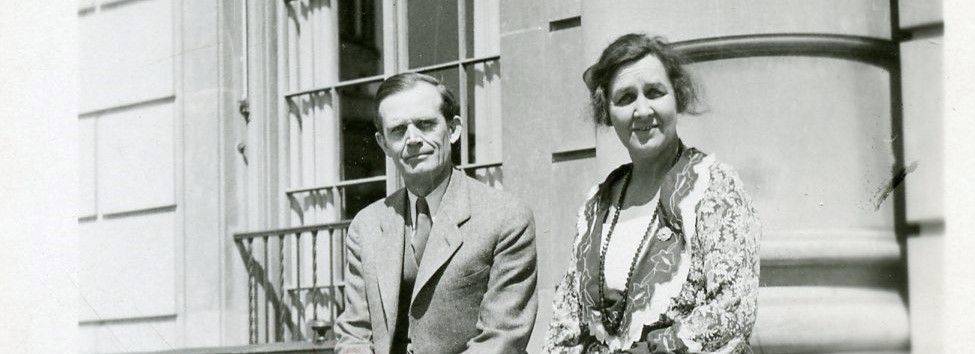
Florence Quay Edmonds in the Archives
“No story about International House would be complete without a write-up about Florence [Quay] Edmonds.” – Harry Edmonds

Florence Quay Edmonds, circa 1925 / I-House Archives
In honor of International Women’s Day and Women’s History Month, the Archives is proud to shine a light on the woman who can be referred to as the co-founder of International House, Florence Quay Edmonds. Born Florence Quay in Gaylord, Michigan, on May 13th, 1883, Florence was cousin to Senator Matthew Quay, a Civil War hero and Pennsylvanian politician dubbed the ‘king maker’ by President Benjamin Harrison. Early on, Florence exhibited a passion and talent for the arts and attended the Detroit School of Music. She later became the music director of public schools in Bethlehem, Pennsylvania, where she met Harry Edmonds in 1902 while he was studying at Lehigh University. The pair married in 1904 before moving to New York City in 1905.Florence Quay Edmonds with family, circa 1920s / c/o Alice Lewthwaite
A warm and practical person, it was Florence who implored Harry to “do something about it” after he had his fateful encounter with a lone Chinese student on the steps of Columbia University; and once the couple decided to host students in their home, it was also Florence who provided simple meals and warm hospitality. In his 1969 oral history, Harry recalled, “She was so put together that she could have twenty or thirty-five students for supper in our apartment and not bat an eyelash.” These informal gatherings would later form the basis of the Intercollegiate Cosmopolitan Club and the dinners dubbed “Sunday Suppers,” a tradition that continues today.
Candlelight Sunday Supper, 1925 / I-House Archives
After years of entertaining students in their apartment and then in Columbia’s Earl Hall, the Intercollegiate Cosmopolitan Club struggled to find investors to expand. After an initial unsuccessful meeting with Cleveland Dodge (who would later donate the land I-House was built upon) Harry recalled how Florence once again provided forceful words of advice. “She made one of her characteristic remarks, which were a prod in the back. ‘Well, there must be some other way.’” This encouragement provided the impetus for Harry to seek out other sources of capital and eventually led him on the path to John D. Rockefeller Jr. and his wife, Abby Aldrich Rockefeller, who, with the Dodge family, were integral to the establishment and planning of I-House. When International House opened its doors in 1924, Florence posted this notice throughout the building: “This is a house of echoes. Whatever of love, friendship, and goodwill you sing into it, will come back to you.” At I-House, Florence was a beloved figure. Working along her husband’s side, she created a warm, home-like atmosphere. Elizabeth Babbot, who served on the first Board of Trustees, remembered that many residents regarded Florence as a mother-like figure. Such was their affection that on her birthday in 1930, the residents surprised her with a party. They also established a fund to commission her portrait to hang in the Home Room, so, as South African resident Peter Cook put it in her memorial service, “[all] might share in the joy of knowing her.” However, a few years had passed since Florence’s birthday when, due to her failing health, Harry realized time was running out. In December 1932, Frank O. Salisbury, a famous portrait painter from England, delayed his trip home to paint Florence at the St. Regis Hotel in New York, NY. When I-House unveiled the piece to residents and staff on Christmas Eve, the “paint was still wet.” Sadly, Florence passed away shortly after, on January 4th, 1933.
The New York Sun, January 5, 1933 / I-House Archives
In the days following her death, Davis Hall was “packed to the roof with the largest audience ever assembled,” as students, staff, and alumni gathered to mourn and remember the woman they loved and admired. At her memorial service, John D. Rockefeller Jr. said: “To have known Mrs. Edmonds is to have sat in the bright sunlight; to have enjoyed the exquisite color and the fragrance of roses; to have breathed deep of the refreshing and exhilarating aid of the mountain tip, and to have witnessed a glorious, never to be forgotten sunset.” Florence’s husband Harry lived for another 46 years and is now attributed as the founder of International House. However, it is worth considering how we might remember Florence if she didn’t die at such a young age. At the time, her obituaries and death notices refer to Florence as the ‘co-founder’ of International House. And looking in the Archives, it is clear that from that first encounter with the Chinese student, when she asked Harry “what he was going to do about it,” to welcoming students into her apartment and curating a home-like experience at the House, Florence was integral to the movement. At the very least, it is certainly fair to say that International House would not exist today were it not for Florence Quay Edmonds.
Florence Quay Edmonds by Frank O. Salisbury, print / I-House Archives
(Banner image: Harry and Florence Edmonds outside International House, 1931 / I-House Archives)
Want to support the Archives? Click below! Have a question? Please email me at Archives@ihouse-nyc.org. Support the Archives
